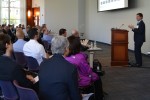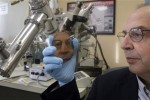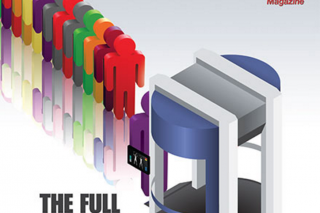News & Events
Innovation Fast Track
ALERT’s work in Improving Security Screening featured in IEEE Antennas & Propagation Magazine September 19, 2016

ALERT Bulk Sensors & Sensor Systems Thrust Leader Professor Carey Rappaport and ALERT Researcher Assistant Professor Jose Martinez Lorenzo’s article on Improving Security Screening: A Comparison of Multistatic Radar Configurations for Human Body Imaging was one of four featured articles in the August issue of IEEE Antennas & Propagation Magazine. The four articles in this issue focused on “various concepts that could enhance future imaging scenarios” and asks the question, “…is it possible to combine all of these ideas into a next-generation advanced imaging system for security and other applications?”.
The article presents the use of a fully multistatic millimeter wave radar system. The radar can be used for imaging concealed objects on the human body at airport security checkpoints with increased speed and accuracy.
ALERT REUs Present Summer Research August 29, 2016

This summer, ALERT hosted three undergraduate students at Northeastern University to participate in a 10-week Research Experience for Undergraduates program. The ALERT REU program at NEU is partnered with other REU programs in the university’s College of Engineering, and builds a cohort of motivated students who attend professional development meetings and program activities, including presentations on Research Ethics, Lab Safety, PowerPoint Presentation Skills and Scientific Storytelling. At the end of the summer, each REU gives a final presentation of their research project. The presentation addresses the project’s overall mission and endeavors, the REU’s specific contributions to the project, as well as what knowledge and skills they gained through the process. This year’s students worked on projects related to ALERT’s Bulk Sensors & Sensor Systems research.
REU Anthony Bisulco (’18) is a third year NU student who worked with Professor Jose Martinez-Lorenzo on ALERT’s Rapid Security Threat Detection via MIMO (Multiple Input, Multiple Output) Millimeter Wave Imaging project.
In his words, “The main purpose of my REU project is to improve the overall passenger experience during the airport security screening process. Currently, this process is plaqued with many downfalls such as slow throughput, frequent false alarms and significant passenger divestment and recollection. The working goal of the project I am working on is to improve this process by creating ‘On the Move Screening’ where passengers walk at a normal pace through what appears to be a tunnel without the need to divest any clothing or personal items.”
Anthony’s project worked to increase the image quality of a 3D imaging millimeter wave radar (“Tunnel System”) with the goal of improving the system’s threat detection capability. “One part of this radar is various transmitters/receivers which illuminate/receiver the target (Human Torso) at various angles. As a result of adding transmitters/receivers the image quality is increased. Rather than adding multiple transmitters or receivers, my project added microwave switches to the system, which is the equivalent of adding more transmitters and receivers for imaging. Overall, I mainly designed the system for controlling these switches and developed some algorithms for optimizing the best imaging positions.”
Spencer Pozder (‘19) and Justin Xia (‘19) worked with Professor Carey Rappaport on Feasibility Investigations in Multistatic Imaging Techniques for their Research Experience. Currently, active millimeter wave radar is used for imaging objects concealed on the human body at airport security checkpoints. The current monostatic configurations are unable to accurately image objects at certain angles, give lower resolution, cost more, trigger more false alarms and have longer execution times. ALERT is interested in a multistatic configuration in an “On the Move” scanning system, capable of receiving image information from multiple angles in parallel, possibly increasing resolution and accuracy of the images produced.
The team developed a product using hardware from ALERT Industrial Partners, Rapiscan and Analog Devices, creating a functional system and imaging algorithm capable of reconstructing images. They also redesigned and relocated transmitter and receiver boards to accommodate the optimized system configuration and designed mechanical structure for holding transmitters and receivers. The “On the Move” system is currently being prototyped and patented.
In addition to this program, ALERT partner universities, including the University of Puerto Rico at Mayagüez and Notre Dame, also hosted summer REU participants in their labs.
The REU program is hosted and sponsored by the Awareness and Localization of Explosives-Related Threats (ALERT) Department of Homeland Security Center of Excellence, and the Bernard M. Gordon Center for Subsurface Sensing and Imaging Systems (Gordon-CenSSIS), a Graduated National Science Foundation Engineering Research Center.
ADSA15: Save the Date! August 19, 2016

The Fifteenth Advanced Development for Security Applications Workshop (ADSA15) will be held on November 15th and 16th at Northeastern University in Boston, Massachusetts. The title of the workshop will be “Next Generation Screening Technologies and Processes for the Checkpoint.” This workshop is a continuation of ADSA12, ADSA13, and ADSA14. The workshop is being convened by the DHS Center of Excellence (COE) for Awareness and Localization of Explosives-Related Threats (ALERT).
Presentation and panel discussions will address the following topics:
- Emerging hardware and algorithms
- Concepts of operations
- Protecting soft targets
- Data analytics – application to aviation security
- System architectures
- Business aspects of fusion
- Funding, innovation and deployment models
For more information on the ADSA workshops, visit our ADSA Workshop Page
This workshop is by invitation only.
If you are interested in learning more, or receiving an invitation, please contact Melanie Smith at [email protected].
REMINDER: White Paper Submissions Due 7/1/2016 June 30, 2016

REMINDER: ALERT White Papers are due TOMORROW. Submissions will be accepted until July 1, 2016, 11:59pm local time.
Pursuant to the goals of DHS Science and Technology (S&T) Directorate, Office of University Programs (OUP), the ALERT Center of Excellence (COE) is accepting white paper submissions for research and transition projects in 2016 and beyond. The COE seeks end-user focused projects that conduct transformational research, develop technology, and provide educational development to improve effective characterization, detection, mitigation and response to explosives-related threats facing the country and the world.
This call will consider white papers for projects ranging from fundamental research through transition to the security enterprise (government, private sector). Submissions must document the problem, describe the gaps that exist, and how their project will address the gaps to protect the public from explosives-related threats. ALERT plans to fund approximately four awards for up to two years at $60,000 to $100,000 per year.
The Call for White Papers is available here: https://alert.northeastern.edu/?p=4738.
Any questions should be directed to [email protected].
Feel free to forward this announcement to others.
Read MoreCurrent Funding Opportunities in the Security Domain May 24, 2016
There are several funding opportunities in ALERT-related topics we would like the community to be aware of. Each of these are actively seeking proposals.
Sandia National Lab Request for Proposals:
https://alert.northeastern.edu/funding-announcement/sandia-national-lab-request-for-proposals/
TSA Innovative Concepts Broad Agency Announcement (TSICBAA):
https://alert.northeastern.edu/?p=4733
TSA Innovation for Aviation Security Broad Agency Announcement:
https://alert.northeastern.edu/?p=4734
DHS S&T Long Range Broad Agency Announcement (LRBAA):
https://alert.northeastern.edu/?p=4735
TSA Industry Day – Innovating the Future Symposium, June 7-9th May 24, 2016
Dates: June 7-9, 2016
Location: TSA Security Integration Facility
The Innovating our Future Symposium is the first in a series of annual technology conferences being hosted by OSC. This three day event will consist of presentations and interactive breakout sessions for a variety of topics, with time made available for questions.
The Innovating our Future Symposium expands upon the following initiatives:
- OSC System Architecture and follow-on technical discussions from Industry Day in February 2016.
- TSA’s Passenger Screening Request for Information (RFI) to be released May 2016.
- TSA’s Primary Carry-on Screening System Targeted Broad Agency Announcement (T-BAA) to be released Fiscal Year 2016 Quarter 2.
- TSA’s Future Innovation Task Force T-BAA to be released Fiscal Year 2016 Quarter 3.
- TSA’s update to the AIT Detection Standards.
- TSA’s future update to the AT Detection Standards.
- TSA update on Cybersecurity
Registration is open: Your written registration must be emailed no later than:
5:00 PM EDT on May 30, 2016 for U. S. Citizens
5:00 PM EDT on May 17, 2016 for Non U. S. Citizens
Details on the event can be found at:
5/19 – DHS S&T Center of Excellence Technology Showcase May 9, 2016

Registration is open!
Date: May 19, 2016
Time: 9:00 am – 4:00 pm
Location: Washington, DC
The DHS Science and Technology Directorate (S&T) Office of University Programs and Stevens Institute of Technology invite you to attend the Spring 2016 Centers of Excellence(COE) Technology Showcase May 19, 2016 open 9:00 am- 4:00 pm.
Explore tools and technology or talk to experts in:
Border Security – Explosives Detection – Risk and Economic Analysis – Natural Hazards – Data & Visual Analytics – Food Defense – Terrorism Studies – Animal Disease Defense – Maritime and Arctic Security – Critical Infrastructure Resilience – Training Opportunities – Hosting Interns – Working with the COEs
- Experience demonstrations of COE tools, technologies, knowledge products
- Connect with university experts (one-on-one if desired) to discuss pressing challenges
- Develop new collaborations to support homeland security missions
- Meet the newest COEs focused on Arctic security; critical infrastructure resilience; and borders, trade and immigration
- Learn how to bring interns and professional development opportunities to your office
See the list of analytical tools that will be showcased on the registration website.
This event is free and open to the public. Please feel free to forward this invitation.
Hosted by Stevens Institute of Technology
Ronald Reagan Building and International Trade Center
Suite G-17
1300 Pennsylvania Ave NW
Washington, DC 20004
Centers of Excellence are a DHS Science and Technology Directorate program managed by the Office of University Programs.
For more information on COEs, visit the Virtual Showcase or email [email protected].
If the registration link above does not work for you, try copying and pasting this into your browser:
Northeastern News spotlights ALERT research in Airport Security Technologies April 28, 2016

FUTURE OF AIRPORT SECURITY – Northeastern News, 4/28/2016
According to the International Air Transport Association, about 8 million travelers make their way through airports around the world each day. Traditional security requires passengers to stand still while being screened, but Northeastern researchers are developing cutting-edge technology that can detect suspicious behavior—even when passengers are on the move…
Profs. Camps, Martinez, Radke, Rappaport, and Sznaier’s work is featured in this dynamic video story.
Read MoreTESSA02 Final Report Now Available April 1, 2016
The final report from the TESSA 02 Workshop, Fundamentals and Advances in Trace Sampling and Detection Workshop Information, is now available for download.
Read MoreThe Associated Press features ALERT Researcher Otto Gregory’s work February 17, 2016

SOUTH KINGSTOWN, R.I. (AP) — A University of Rhode Island professor has developed a sensor that detects the kind of explosive used in the Paris bombings, to try to stop future attacks.
Professor Otto Gregory compares his sensor to a dog’s nose, the gold standard in explosives detection. It “sniffs” the air for vapors emitted from explosives.
Photo Description: In this Tuesday, Jan. 26, 2016 photo University of Rhode Island engineering professor Otto Gregory, right, is reflected in a silicon wafer, center, that contains sensors to detect explosives, in front of a thin film surface analyzer, behind, in a laboratory on the school’s campus, in South Kingstown, R.I. He has developed a sensor that detects the explosive used in the Paris bombings, to try to stop future attacks. Gregory compares his sensor to a dog’s nose, the gold standard in explosives detection. It “sniffs” the air for vapors emitted from explosives. (AP Photo/Steven Senne)

